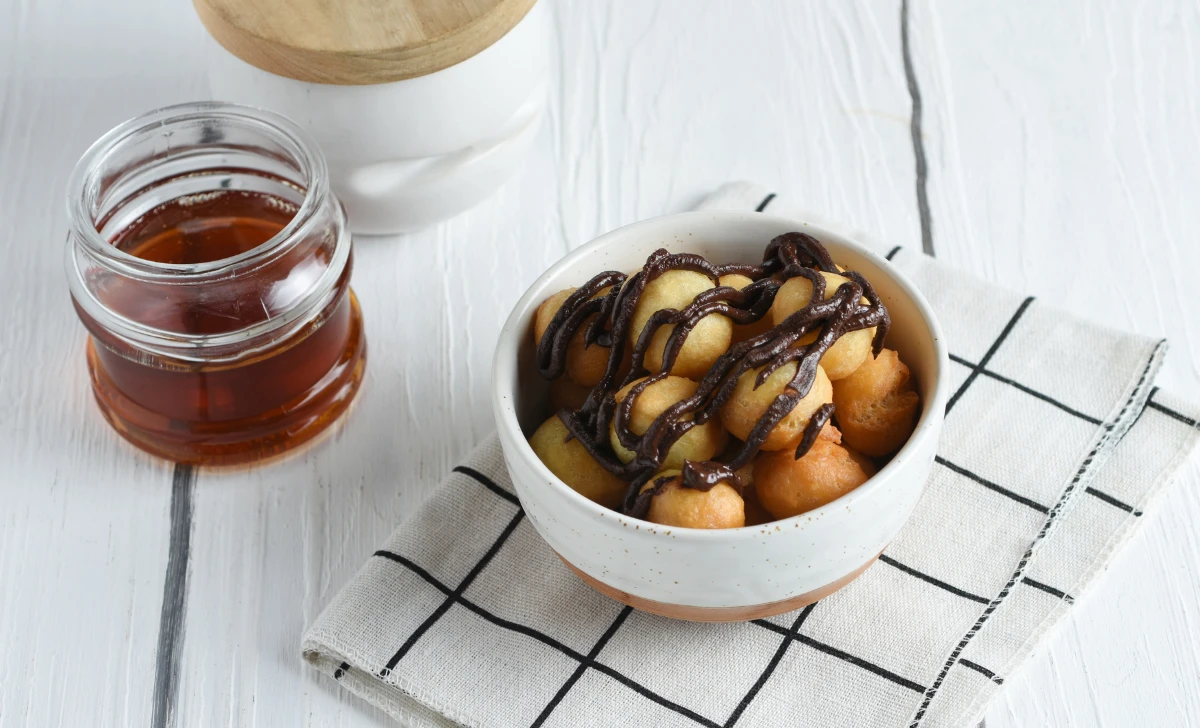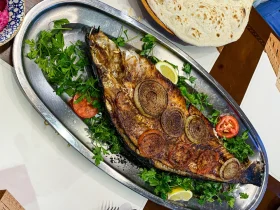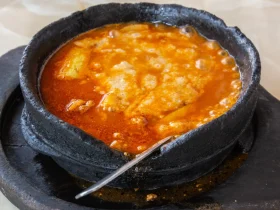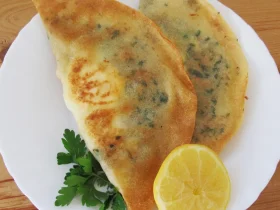Lokma, those delectable bite-sized morsels of deep-fried dough drenched in sweet syrup, are a treat that transcends time and borders. These delectable Turkish delights have been satisfying taste buds for generations. If you’re ready to embark on a culinary adventure and bring the flavors of Turkey into your kitchen, then this Lokma recipe is your golden ticket. Get ready to unleash your inner chef and create a delightful batch of Lokma that will leave everyone craving for more.
[ez-toc]
History
Lokma, those bite-sized spheres of delight that grace our taste buds with their sweet embrace, hold within them a rich history that spans centuries and cultures. Originating from the heart of Turkey, Lokma’s journey is one of evolution, cultural exchange, and a testament to the human penchant for culinary creativity.
Ancient Origins and Ottoman Delights
The story of Lokma traces its roots back to the Ottoman Empire, a realm that encompassed vast territories and diverse cultures. The concept of deep-fried dough soaked in syrup was already present in various forms across different cultures in the region. However, it was within the bustling kitchens of the Ottoman palaces that Lokma found its refined form.
The term “lokma” itself translates to “morsel” or “mouthful” in Turkish, which perfectly encapsulates the essence of these delectable treats. Lokma was not just a culinary creation; it was an experience – a single, exquisite bite that transported one to realms of sweetness and indulgence.
A Delightful Journey Across Borders
As the Ottoman Empire expanded its reach, so did the fame of Lokma. From the bustling bazaars of Istanbul to the spice markets of Cairo, the delicacy captured the hearts of those who tasted it. The portability and addictive nature of Lokma made it a favored treat among travelers and traders, turning it into a delectable ambassador of Turkish culture.
Lokma’s journey did not stop at the borders of the Ottoman Empire. It embarked on a voyage of globalization, spreading its delicious influence to distant corners of the world. As trade routes intertwined and cultures mingled, Lokma found its way into the culinary fabric of various societies, each adding its unique twist to the recipe.
Cultural Infusions and Contemporary Charms
In Greece, Lokma is known as “Loukoumades,” a name that reflects the sweet and airy nature of these delectable morsels. Similarly, in the Arab world, the dessert is celebrated as “Lokmet el qadi,” gracing tables during festive occasions and family gatherings.
As Lokma traversed continents, it absorbed diverse culinary traditions, incorporating regional ingredients and techniques. From the shores of the Mediterranean to the heartlands of Asia, each culture contributed to the evolution of Lokma, making it a true testament to the beauty of cross-cultural pollination.
Lokma Today: A Modern Icon
In the modern world, Lokma continues to reign supreme as a beloved dessert. Its charm lies not only in its taste but in the memories and emotions it evokes. From street vendors in Istanbul to gourmet dessert parlors in New York City, Lokma has found its place in the hearts of both traditionalists and innovators.
Cooking enthusiasts and foodies around the globe have embraced Lokma, experimenting with flavors, fillings, and presentations. The internet age has further propelled its popularity, making it a star in culinary blogs, cooking shows, and social media feeds.
Preserving Tradition, Celebrating Diversity
As we savor the exquisite taste of Lokma today, we become part of a legacy that celebrates the fusion of history and innovation. Lokma’s journey from ancient palace kitchens to contemporary dining tables reflects the essence of culinary artistry – the ability to transform humble ingredients into a symphony of flavors that resonate across time and space.
So, the next time you indulge in a piece of Lokma, remember that you’re not just tasting a dessert – you’re tasting a slice of history, a fusion of cultures, and a testament to the culinary wonders that unite us all.
Time
| Step | Time |
|---|---|
| Blooming the Yeast | 10 minutes |
| Mixing the Dough | 15 minutes |
| Dough Rising | 1 hour |
| Heating the Oil | 10 minutes |
| Shaping and Frying | 20 minutes |
| Creating the Sugar Syrup | 15 minutes |
| Soaking the Lokma | 5 minutes |
| Nutty Delight Lokma Variation | 25 minutes |
| Chocolate Drizzle Lokma Variation | 30 minutes |
| Lokma Presentation | 10 minutes |
| Serving and Pairing Suggestions | 5 minutes |
| Storing Lokma | – |
Please note that the times provided are approximate and may vary based on your experience and kitchen setup. Additionally, the time for storing Lokma is not included in the table since it doesn’t involve active preparation or cooking.
Ingredients
| For the Dough | For the Syrup |
|---|---|
| 1/2 cup all-purpose flour | 1/4 cup sugar |
| 1/2 teaspoon active dry yeast | 1/8 cup water |
| 1/8 teaspoon salt | 1/2 teaspoon lemon juice |
| 1/4 teaspoon sugar | A touch of rose or orange blossom water (optional) |
| 1/4 cup warm water |
Directions
Preparing the Lokma Dough
Step 1: Blooming the Yeast
- In a small bowl, dissolve 1/4 teaspoon of sugar in 1/4 cup of warm water.
- Sprinkle 1/2 teaspoon of active dry yeast over the water and sugar mixture.
- Allow the yeast to bloom for about 5-10 minutes, or until it becomes frothy and bubbly.
Step 2: Mixing the Dough
- In a mixing bowl, combine 1/2 cup of all-purpose flour and 1/8 teaspoon of salt.
- Gradually pour the bloomed yeast mixture into the flour mixture, stirring continuously to form a sticky dough.
- Cover the bowl with a clean kitchen towel and let the dough rise for about 1 hour, or until it has doubled in size.
Frying the Lokma to Golden Perfection
Step 1: Heating the Oil
- Fill a deep frying pan with enough oil for deep frying, about 2 inches deep.
- Heat the oil over medium heat until it reaches a temperature of 350°F (175°C). Use a kitchen thermometer to ensure accuracy.
Step 2: Shaping and Frying
- Dip a spoon in water to prevent sticking, then scoop a small portion of the risen dough.
- Gently drop the dough into the hot oil, using another wet spoon to slide it off.
- Fry the Lokma in batches, ensuring not to overcrowd the pan, until they turn golden brown and puffy, about 2-3 minutes per side.
- Use a slotted spoon to transfer the fried Lokma onto a plate lined with paper towels to drain excess oil.
Creating the Irresistible Syrup
Step 1: Making the Sugar Syrup
- In a saucepan, combine 1/4 cup of sugar and 1/8 cup of water.
- Bring the mixture to a gentle boil, stirring until the sugar is completely dissolved.
- Add 1/2 teaspoon of lemon juice to the syrup, which helps prevent crystallization and adds a hint of tanginess.
- Simmer the syrup for a few minutes until it slightly thickens.
- Optionally, add a touch of rose or orange blossom water for a delightful floral aroma.
Step 2: Soaking the Lokma
- Carefully place the fried Lokma into the warm sugar syrup, ensuring they are fully submerged.
- Allow the Lokma to soak in the syrup for about 5 minutes, flipping them halfway through, to absorb the sweetness.
Presenting and Serving the Lokma
Step 1: Arranging and Presenting
- Arrange the soaked Lokma on a serving platter, allowing any excess syrup to drip off.
- You can sprinkle powdered sugar over the Lokma for an elegant touch.
Step 2: Serving and Pairing Suggestions
- Serve the Lokma warm for the best flavor and texture.
- Consider pairing the Lokma with a scoop of vanilla ice cream for a delightful contrast of temperatures and flavors.
- A cup of strong Turkish coffee makes for a perfect accompaniment to balance the sweetness of Lokma.
Storing Your Lokma
- Place any leftover Lokma in an airtight container once they have cooled.
- Store at room temperature for up to 2 days to maintain their freshness and texture.
- To enjoy them again, warm the Lokma in an oven at a low temperature for a few minutes before serving.
With these steps, you’re now equipped to create a batch of scrumptious Lokma that will have everyone savoring the delightful fusion of flavors and textures. Enjoy your culinary adventure!
Equipment Required
Nutrition Information
| Nutrient | Per Serving |
|---|---|
| Serving Size | 4 pieces |
| Calories | 180 kcal |
| Total Fat | 7g |
| Saturated Fat | 1g |
| Trans Fat | 0g |
| Cholesterol | 0mg |
| Sodium | 50mg |
| Total Carbohydrates | 27g |
| Dietary Fiber | 1g |
| Sugars | 10g |
| Protein | 3g |
| Vitamin D | 0% |
| Calcium | 0% |
| Iron | 6% |
| Potassium | 2% |
Please note that these values are approximate and can vary based on specific ingredients and portion sizes. It’s always a good idea to refer to nutrition labels on individual product packages and consult with a registered dietitian for precise dietary information.
Tips
- Consistency is Key: While mixing the dough, aim for a sticky but manageable consistency. Adjust the water or flour as needed to achieve the right texture.
- Precision Frying: Maintain a consistent oil temperature around 350°F (175°C) for evenly cooked and crispy Lokma. Use a kitchen thermometer to monitor the temperature.
- Syrup Saturation: Ensure the syrup is warm when soaking the Lokma to enhance syrup absorption and flavor.
- Small Batches: Fry the Lokma in small batches to avoid overcrowding the pan, which can lead to uneven frying and soggy results.
- Oil Draining: After frying, place the Lokma on a paper towel-lined plate to absorb excess oil and maintain their crispiness.
- Enhance Aesthetics: Sprinkle crushed nuts, such as pistachios or walnuts, over the soaked Lokma for added texture and visual appeal.
- Floral Notes: Experiment with different floral waters like rose, orange blossom, or even lavender to infuse unique aromas into your syrup.
Pros & Cons
| Pros | Cons |
|---|---|
| ✅ Irresistibly delicious and indulgent dessert. | ❌ High in calories and sugar. |
| ✅ Offers a unique cultural and culinary experience. | ❌ Deep-frying may not suit those minimizing oil consumption. |
| ✅ Versatile with various flavor variations. | ❌ Requires careful temperature management for frying. |
| ✅ Great for special occasions and gatherings. | ❌ Time-consuming process with multiple steps. |
| ✅ Provides an opportunity for creative presentation. | ❌ Potential for mess and oil splatter during frying. |
Conclusion
In the world of culinary delights, few experiences can match the sheer pleasure of savoring a warm, syrup-drenched Lokma. As we embarked on this journey through the rich history, step-by-step preparation, and tantalizing variations of this Turkish gem, we’ve uncovered more than just a recipe. Lokma is a celebration of tradition, a fusion of cultures, and a testament to the artistry of flavors.
From the moment the yeast blooms, to the sizzle of dough meeting hot oil, and the delicate dance of Lokma soaking in luscious syrup – every step is a labor of love that culminates in a bite-sized piece of perfection. Whether you’re relishing the classic version, experimenting with nutty textures, or indulging in a chocolate-drenched fantasy, Lokma promises a sensory adventure that tantalizes your taste buds and warms your heart.
So, my fellow culinary explorers, I invite you to take up the mantle of Lokma creation. Embrace the aroma, the flavors, and the shared joy it brings. Whether you’re a seasoned chef or a kitchen novice, this recipe invites you to channel your inner chef and craft a dessert that not only fills your plate but also weaves memories around your table.
Gather your ingredients, fire up your frying pan, and immerse yourself in the art of Lokma-making. Let the sweet aromas fill your kitchen and the anticipation build with each golden-brown morsel. Unleash your creativity in presentation, pairings, and variations – for Lokma is more than just a recipe; it’s an experience waiting to be savored.
Dive into the world of Lokma and discover the joy of creating a treat that transcends boundaries and captivates hearts. Your taste buds will thank you, and your culinary journey will be forever enriched. So, why wait? The Lokma adventure beckons, and a delectable realm of flavors awaits your exploration. Happy cooking! 🍽🥮
Facts
- Fact 1: Sweet Sultans and Imperial Delights 🌟
- Did you know that Lokma’s origins trace back to the opulent palaces of the Ottoman Empire? These delectable dough bites were a favorite of the sultans and royalty, served as a symbol of extravagance and indulgence. Lokma’s journey from palace kitchens to global fame is truly a tale fit for a culinary king!
- Fact 2: Fritter Fables and Sizzling Science 🔥
- The art of frying Lokma isn’t just about taste – it’s a science! As the dough hits the hot oil, a mesmerizing dance unfolds. The heat causes moisture in the dough to turn into steam, creating pockets that transform the dough into airy, golden-brown wonders. It’s a sizzling symphony of culinary chemistry that’s as captivating as it is delicious!
- Fact 3: Loukoumades and the Ancient Olympics 🏟️
- Lokma’s Greek cousin, Loukoumades, has an intriguing historical connection. These delectable dough balls were offered to athletes during the ancient Olympic Games in Greece! Imagine ancient champions fueling up on sweet energy bites before competing in the grand arenas of Olympia. A tasty tradition that fueled both body and spirit!
- Fact 4: Delightful Diversity and Flavor Fusion 🌍
- Lokma’s journey didn’t stop in Turkey. As it traveled through time and across borders, it absorbed flavors from different cultures like a culinary sponge. From the bustling streets of Istanbul to the cozy kitchens of Greek islands, each region added its unique twist to this sweet masterpiece. Lokma truly embodies the global spirit of flavor fusion!
- Fact 5: Lokma Legends and Family Feasts 🎉
- In Turkish culture, Lokma isn’t just a dessert – it’s a symbol of sharing and celebration. During special occasions like weddings and religious festivals, families gather to prepare and enjoy Lokma together. It’s a joyful tradition that’s passed down through generations, uniting loved ones over shared stories, laughter, and, of course, plates of delectable Lokma!
FAQ’s
Can I use whole wheat flour instead of all-purpose flour for the dough?
Yes, you can substitute whole wheat flour for all-purpose flour. Keep in mind that whole wheat flour may yield a slightly denser texture and nuttier flavor.
Is there a way to make Lokma without frying them?
While frying is traditional, you can try baking the dough in a preheated oven at 375°F (190°C) for about 15-20 minutes for a lighter version. However, the texture and taste will differ from the deep-fried version.
Can I make the dough ahead of time and fry it later?
Yes, you can prepare the dough ahead of time, cover it tightly, and refrigerate. Bring the dough to room temperature before frying for optimal results.
Can I freeze Lokma for future consumption?
Yes, you can freeze fried and cooled Lokma in an airtight container for up to 2 months. Reheat in the oven to restore their crispiness.
Are there alternatives to using rose or orange blossom water in the syrup?
Absolutely, you can use vanilla extract, almond extract, or a small amount of lemon zest to add delightful flavors to the syrup.
Can I make Lokma without a kitchen thermometer?
While a thermometer ensures precise frying temperature, you can test the oil readiness by dropping a small piece of dough. If it sizzles and rises to the surface, the oil is likely ready for frying.
Can I use an air fryer to make Lokma?
Air fryers can yield a different texture, but you can experiment by lightly brushing the shaped dough with oil and air frying at 350°F (175°C) for about 10-12 minutes, turning halfway through.
How can I prevent the dough from sticking to my hands when shaping?
Wetting your hands with water or a little oil before shaping the dough will help prevent sticking.
Can I reduce the amount of sugar in the syrup?
You can adjust the sugar to taste, but keep in mind that the syrup provides sweetness and moisture to the Lokma. A reduced sugar content might impact the final result.
What can I do with leftover syrup?
Leftover syrup can be stored in the refrigerator and used to sweeten other desserts, beverages, or even drizzled over pancakes and waffles for an extra touch of flavor.












Leave a Review